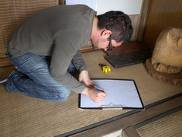Miyagi Network News vol.143
August 17, 2011 Leave a comment
—‘Topos’ in Karakuwa, the preservation activity in Kesennuma City
This is Daisuke Sato, secretariat officer of the Miyagi Network for Preserving Historical Materials. Today I’d like to introduce you to the preservation activity for the S family’s house by the architecture team in Karakuwacho, Kesennuma City, from 21st to 24th of August.
As for the outline of the S family and its extent of damage, please see the Miyagi Network News vol.132. In this operation, we carried out the measurements of the main house which was completed in 1897 and the whitewashed warehouse and the board fences which were built prior to the main house. By the advertisement from the architecture team, 16 members came from Tokyo, Kanazawa and Osaka, and they were composed of mainly the members of Prof. Hiroshi Oota’s seminar in the Institute of Industrial Science, the University of Tokyo.
According to them, this was the first time for the student members to measure old structures, however, Mr Kiyohide Muto who had worked on many traditional structures as an architect gave them advice, and we carried out the measurement mainly for the granary, wood-made warehouse where the 3 Sendai Domain soldiers who were beaten at the Boshin War(*) barricaded, and the stable. On the other hand, the 3 foreign students from Portugal, Brazil and Greece measured the main house which the Kesen Daiku (meaning carpenters in the Kesen area) paid tribute to their craftsmanship by carefully confirming the Japanese traditional calibrated scale. In this operation, as for the ground plans, we can roughly say we could finish each measurement except for the warehouse of the books, because there was a risk that the roof tiles would fall down due to the approaching typhoon. With regard to the measurement of the rest of the structures and the elevation plans, we will carry them out in the second half of August. In addition, we surveyed how much the structure inclined by using measuring instruments, however, the inclination was only 5mm towards the 1800mm pillar. It meant that this structure was invulnerable to the two great earthquakes of 1936, 1978 and the East Japan Earthquake which occurred after the establishment of these structures. The Kesen carpenters’ certain technological strength was authenticated.
Simultaneously, a member of Prof Oota’s seminar group will support making the reconstruction plans for this community. For this reason, the exchange meeting with people concerning the local residents’ association in the assembly hall near the S family’s house was held on the night of 22nd July. We sat up all night around the miniature model town and openly talked about the characteristics of the community, how the Tsunami flooded this area, and the present issues for their reconstruction. At the same time, coincidentally enough, since last year Prof Oota’s seminar group had researched the urban planning of Lisbon where the great earthquake and tsunami occurred in 1755, so they introduced us to the 50-year-spanning process of their reconstruction. The local people were deeply impressed by it and said that they would try to tackle the long-term reconstruction learning from this example.
As for myself, it was fruitful to grasp the experience of learning the past that could contribute the reconstruction. At the same time, however, I keenly realised my weakness as a researcher, because I could explain nothing about the process of reconstruction in Karakuwa and other coastline areas from the Sanriku Earthquake in 1935 and 1978.
At this investigation, we stayed in the local assembly hall through the S family’s courtesy, because the local accommodation was occupied by the people involved with the reconstruction operation. In terms of our meals, S family asked 2 housewives to serve us, so we could carry out the activity. Both of them lost their houses due to the Tsunami though, they warmly gave us hospitality in such a difficult situation. Taking this opportunity, we would like to express our gratitude to the S family and the local people.
During our activity, we could have an opportunity to hear the traditional folk songs concerned with skipjack pole-and-line fishery designated as the city’s intangible cultural property in the reconstruction event on the night of 23rdJuly. For these 4 days, we could fully feel not only the S family’s old structure and the present condition in the community, but also the ancestral culture.
At the leaving salutation, the foreign student from Greece said that Greek had a word ‘Topos’ which indicated ‘place’, and this word included the whole meaning of history, climate, and culture in that area. This spot in Karakuwa was indeed ‘Topos’ and this activity became a good experience for him, he said to the master of the house. As I listened to his story, I felt that the rescue operations for the historical materials will protect the old archives, folk-cultural properties and art, as well as to be the activity for taking over the Tohoku People’s daily life, and the climate and landscape based on their tradition, that is to say, to inherit the ‘Topos’.
NB: The photos are all from the homepage of the Miyagi Network for Preserving Historical Materials.
*Boshin War(戊辰戦争): occurred from 1868-1869. the war being a fight between a mixed group of mainly Satsuma(薩摩) and Choshu(長州) against the Tokugawa Shogunate soon after when the last Tokugawa Shogun regime returned to the Emperor. By this war, the ally group for the Tokugawa Shogun was completely defeated.



